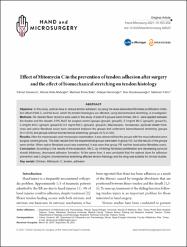| dc.contributor.author | Güvercin, Yılmaz | |
| dc.contributor.author | Abdioğlu, Ahmet Atilla | |
| dc.contributor.author | Baki, Mehmet Emre | |
| dc.contributor.author | Kerimoğlu, Gökçen | |
| dc.contributor.author | Karahasanoğlu, İlker | |
| dc.contributor.author | Yıldız, Mehmet | |
| dc.date.accessioned | 2023-02-06T08:03:28Z | |
| dc.date.available | 2023-02-06T08:03:28Z | |
| dc.date.issued | 2021 | en_US |
| dc.identifier.citation | Güvercin, Y., Abdioğlu, A.A., Baki, M.E., Kerimoğlu, G., Karahasanoğlu, İ. & Yıldız, M. (2021). Effect of Mitomycin C in the prevention of tendon adhesion after surgery and the effect of biomechanical stretching on tendon histology. Hand and Microsurgery, 10(3), 193-202. http://doi.org/10.5455/handmicrosurg.69020 | en_US |
| dc.identifier.issn | 2458-7834 | |
| dc.identifier.uri | http://doi.org/10.5455/handmicrosurg.69020 | |
| dc.identifier.uri | https://hdl.handle.net/11436/7532 | |
| dc.description.abstract | Objective: In this study, optimal dose to reduce tendon adhesion, by using the dose-dependent fibroblast proliferation inhibition effect of Mit-C, and the level, which the tendon histologies are affected, using biomechanical stretching, is investigated.
Methods: 56 chicken flexor tendons were used in this study. A total of 9 groups were formed. Mit-C were applied between
the tendon and the sheath; 0.9% NaCl for surgical control groups (groupII, groupIII), 0.1mg/ml Mit-C (groupIV, groupVII),
0.2mg/ml Mit-C (groupV, groupVIII) 0.5 mg/ml Mit-C (groupVI, groupIX). Macroscopic, microscopic, synovial sheath thickness and active fibroblast count were compared between the groups that underwent biomechanical stretching (groups
III,V,VII,IX) and groups without biomechanical stretching (groups I,II,IV,VI,VIII).
Results: After the macroscopic and microscopic examination, it was observed that the groups with the most adhesion were
surgical control groups. The best results from the experimental groups were seen in group VIII, but the results of the groups
were similar. When active fibroblast count was examined, it was seen that group VIII had the least active fibroblast count.
Conclusion: According to the results of the evaluation, Mit-C, by inhibiting fibroblast proliferation and decreasing synovial
sheath thickness, decreased adhesion formation. At the same time, it was concluded that the optimal dose for adhesion
prevention was 0.2mg/ml, biomechanical stretching affected tendon histology and the drug was suitable for clinical studies. | en_US |
| dc.language.iso | eng | en_US |
| dc.publisher | Türk El ve Üst Ekstremite Cerrahisi Derneği | en_US |
| dc.rights | info:eu-repo/semantics/openAccess | en_US |
| dc.subject | Chicken | en_US |
| dc.subject | Mitomycin C | en_US |
| dc.subject | Tendon | en_US |
| dc.subject | Adhesion | en_US |
| dc.title | Effect of Mitomycin C in the prevention of tendon adhesion after surgery and the effect of biomechanical stretching on tendon histology | en_US |
| dc.type | article | en_US |
| dc.contributor.department | RTEÜ, Tıp Fakültesi, Cerrahi Tıp Bilimleri Bölümü | en_US |
| dc.contributor.institutionauthor | Güvercin, Yılmaz | |
| dc.identifier.doi | 10.5455/handmicrosurg.69020 | en_US |
| dc.identifier.volume | 10 | en_US |
| dc.identifier.issue | 3 | en_US |
| dc.identifier.startpage | 193 | en_US |
| dc.identifier.endpage | 202 | en_US |
| dc.relation.journal | Hand and Microsurgery | en_US |
| dc.relation.publicationcategory | Makale - Uluslararası Hakemli Dergi - Kurum Öğretim Elemanı | en_US |


















